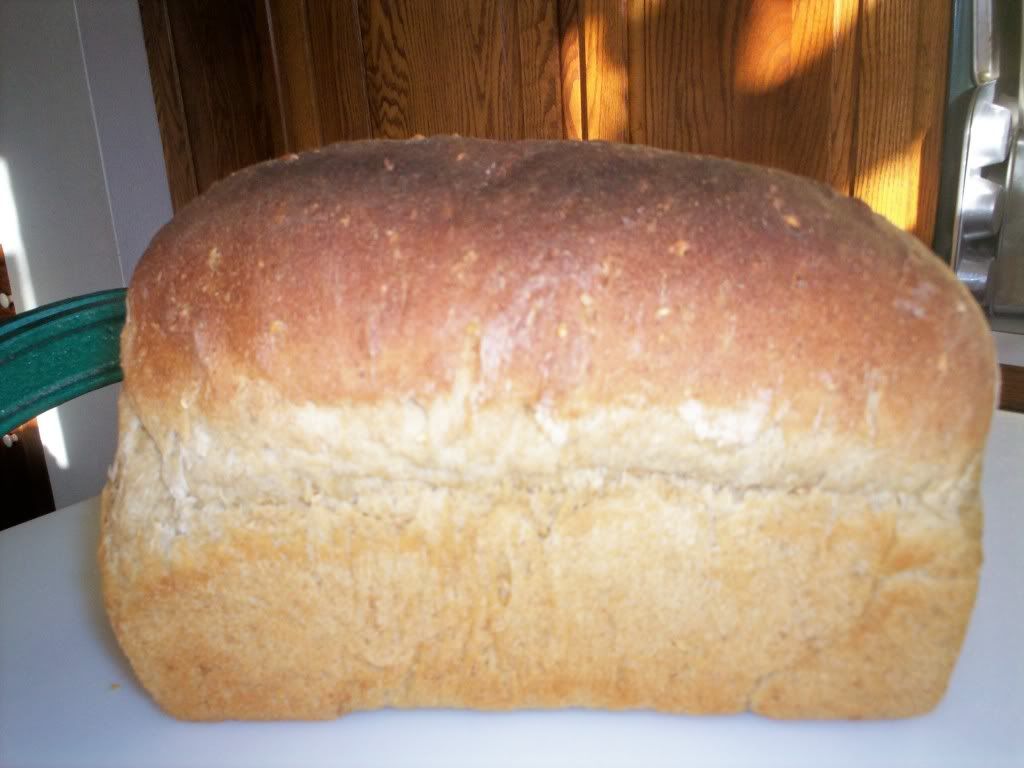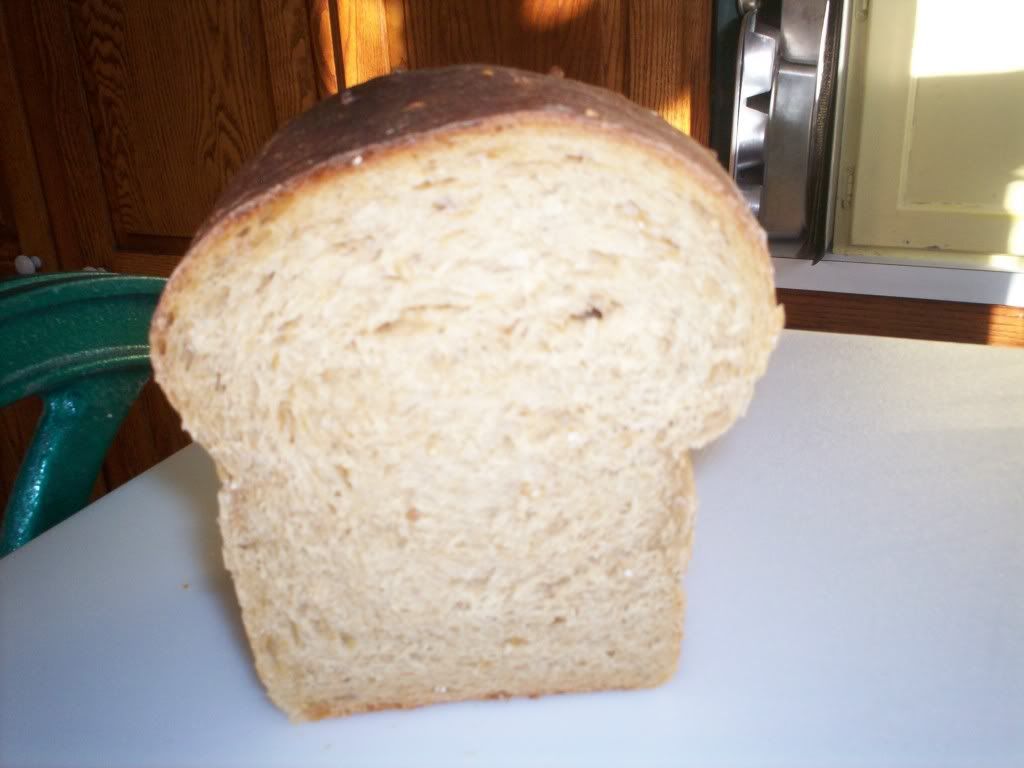It was 1967 when the classic Star Trek episode "The Trouble with Tribbles" was first broadcast. As I mentioned before, it was a different time and I was not yet the worldly sophisticate that I am today. "Quadrotriticale" seemed like a wonderful, fictional, impossible grain of the future.
When I discovered that triticale (trit ih KAY lee) was indeed a real grain, it immediately became my "favorite" for no other reason than it reminded me that the "impossible" could become real.
Unfortunately, according to the University of Wisconsin, its desirability for bread making is less than that of wheat (but more than that of rye!) and my own first experience with it bore that out.
But it remains my favorite and after my long baking/milling hiatus this panned bread project seemed like the ideal time to resume my obsession with this grain. How, exactly, to use it was the question.
So I put my tiny mind to work bringing together bits and pieces of what I learned in the past year. Given that the gluten quality in triticale is low and given that a pre ferment (particularly a firm pre ferment) can be used to help increase gluten strength, it seemed that I should use triticale in the pre ferment. So after coming home from work (which involves things like full body scans) I fired up the mighty Diamant. I did a three pass grind to produce sufficient whole grain triticale flour to pre ferment 10% of the total flour. Why 10%? No reason except that I had liked the 5% pre ferment bread and was determined to push it just a little bit more. I decided to stay with a levain based pre ferment (as it had survived last week's elimination round) and to reduce the yeast very slightly to make up for a higher percentage of flour pre fermented.
Triticale handles like rye, but more so. The 60% hydration pre ferment felt and acted like modeling clay. After 10 hours it did not appear to be mature, but when I poked it around a little, it had expanded slightly and showed pockets of air. If it had been wheat or if I were counting on the pre ferment for all the leavening in the bread, I would have been alarmed, but I was just doing this for taste and perhaps a little increase in strength, so I went ahead and mixed the dough. It was tacky, not sticky and in general was a lovely dough to work with.
My feverish formula fussing had caused me to slightly increase the amount of total flour from the original recipe, but once shaped and put into pans, I realized that the pan sizes that served me well up until now were no match for this version. It rose like gangbusters, both during proofing and in the oven.
So here is a picture of the loaf and the crumb, revealing tragic shaping flaws, the results of too small a pan, and a fine grained crumb (as I told you - brown loaf - fine crumb.) I do admire those folks with the presence of mind to take pictures during the process, but even when faced down with a scary pre ferment I still lack the verve it takes to document it pictorially.


It was - delicious. I always sample my loaves, but frankly I'm baking a lot of different types of things these days (I am working on other things besides this panned bread) and if I let myself just eat what I wanted, well, I would be twice the person I am now and I'm not sure that would be good. But this stuff was too good to not eat. It is a very soft bread perfect for those (deadly, I am told) soft bread sandwiches, but also very tasty just plain and extra good toasted.
The formula: (All of last week's warnings apply...)
|
Total Dough Wt |
|
62.478 |
oz |
Levain |
|
|
|
|
|
|
|
Ingredients |
|
|
Percent of Flour in Levain |
0.1 |
|
Final Dough |
|
|
|
|
% |
Wt |
UOM |
% |
WT |
UOM |
Ingredients |
Wt |
UOM |
|
Total Flour |
1 |
27 |
oz |
1 |
2.7 |
oz |
Total Flour |
24.3 |
oz |
|
KA AP Flour |
0.9 |
24.3 |
oz |
|
|
|
KA AP Flour |
24.3 |
oz |
|
Triticale Flour |
0.1 |
2.7 |
|
1 |
2.7 |
oz |
|
|
|
|
Levain Water |
0.06 |
1.62 |
|
0.6 |
1.62 |
oz |
|
|
|
|
Rolled Oats |
0.17 |
4.59 |
oz |
|
|
|
Rolled Oats |
4.59 |
oz |
|
Steel Cut Oats |
0.11 |
2.97 |
oz |
|
|
|
Steel Cut Oats |
2.97 |
oz |
|
Boiling water |
0.74 |
19.98 |
oz |
|
|
|
Boiling water |
19.98 |
oz |
|
Shortening(leaf lard) |
0.04 |
1.08 |
oz |
|
|
|
Shortening(leaf lard) |
1.08 |
oz |
|
Molasses |
0.112 |
3.024 |
oz |
|
|
|
Molasses |
3.024 |
oz |
|
Milk Powder |
0.04 |
1.08 |
oz |
|
|
|
Milk Powder |
1.08 |
oz |
|
Salt |
0.028 |
0.756 |
oz |
|
|
|
Salt |
0.756 |
oz |
|
Yeast |
0.006 |
0.162 |
oz |
|
|
|
Yeast |
0.162 |
oz |
|
|
|
|
|
|
|
|
|
|
|
|
|
|
|
|
|
|
|
|
|
|
|
|
|
|
|
|
|
|
|
|
|
|
Seed |
0.008 |
0.216 |
oz |
0.08 |
0.216 |
oz |
Levain |
4.536 |
oz |
|
Totals |
2.314 |
62.478 |
oz |
1.68 |
4.536 |
oz |
|
62.478 |
|
Combine the two types of oats, boiling water, milk powder and shortening. Allow to cool to lukewarm.
Add the salt, molasses, yeast, levain, and flour. Mix 5 minutes on the single speed of the spiral mixer. Or use your preferred method of mixing.
Let rise until doubled - 2 hours at 78-80F. Fold. Let rise again - about 2 hours 78-80F. (Note the change - this one really needed the warmth to get it going!)
Shape and place in greased pans. Proof (1 hour) and bake at 375F for 40 minutes. Remove from pans and cool on a rack.
In a previous life I studied with a costume designer (actually, quite a famous one) who once told me that you keep adding until you think you have added enough and then - add one more thing. So I am now faced with a decision about the direction of my experimenting. Not only is triticale my favorite grain, but it really added a dimension to this bread. Do I push the percentage ever higher? Or do I call enough, enough and start tweaking other aspects of the formula? Life is pretty good when those are the kind of decisions you get to make. Stay tuned.
- proth5's Blog
- Log in or register to post comments
It's quite a entertaining reading (and quite educational too). It made me curious about this grain, Triticale.
Proth5,let's go boldly where no man has gone before...let's experiment more. I love reading and learning about your bread adventure.
Sue
http://youcandoitathome.blogspot.com/
for the kind words.
Formula development will continue - I've got a few things I want to try.
I wish I was as fearless as MiniOven, but I am more suited to methodical plodding. I'll be sure to write stuff up.
Where no ONE has gone before...
..where few bakers have gone before: quintotriticale!
While I found info on triticale in Bread, it was also noted that in the US it's primarily grown for livestock feed. Looks like you made a silk purse out of sow's feed, Pat.
Silliness aside, it's a very pretty loaf. Where do you source triticale?
BTW, I trust you received your Breadville USA 2011 map?
"The Trouble with Tribbles" in Wikipedia and you will find some interesting stuff on the grain names.
Yep - feed the good stuff to the animals. The gluten is problematic, but the taste is very nice. It deserves better than it gets. Stay tuned for more adventures. I buy the whole grains from Bob's Red Mill.
My house sitter had helpfully put my Breadville USA mailing in the junk mail pile - thanks for letting me know. August. Denver. Wild dogs will not be able to keep me away. :>)
We have a pet tribble--not live; battery-operated: (http://www.thinkgeek.com/geektoys/plush/ac6e/?cpg=froogle). So I especially enjoyed your story. The bread looks great. You should probably try a higher percentage of triticale. Because if it's great, we need to know.
Glenn
A higher percentage, eh? Wonder if I did... Stay tuned.
Great work! That sandwich loaf has a fantastic profile when sliced... might have to make this one.
ben
That profile comes from using a 3.5"X7.5" pan when I should have used the 4.5"X9.5" pan - but if you like it - that's the way to go...
Thanks for the kind words.
Hi Proth5,
"Do I push the percentage higher"..........keep experimenting, only your taste buds will tell you when you have reached your limits.........and of course "where no man has been before"........as for the shape I get the same when using my pan tins as well. I call it my mushroom loaf.......slice a mushroom in half down the stem(still on) and you will see why!!!! You state that your pans are too small......reverse the thinking.........are you sure that your not placing too much dough in your pan. I like the mushroom shape for sandwiches anyway, so what the heck.
Intresting notes and thanks for sharing............Pete
PS I like star trek as well.............but not enough to call myself a "Trekkie"
for the kind words. This is meant to be an examination of how I develop a formula - so I ask questions "out load." At some point I will deviate too much from the character of the bread and must stop. At the end I would like to do a comparison of the "adapted formula" vs the original...
The pan that this loaf was baked in is smaller than the standard bread pan (see above) and since I am trying to make two loaves, yes, it is too small to contain what this has become.
Happy Baking!
Hello Proth5:
Thank you for your experiment. Your bread looks great but I don't think that I will have a chance to make it.Darn! I have no way of grinding the Triticale.( And thank you for give us the correct way to pronounce the word. I always thought that it pronounce "Tri-ti -Kale ) By the way, what is a "leaf lard"? Is it crisco?
Keep it coming. I enjoyed reading your post and now "seeing" the picture of your bread!
Mantana
is the lard that is rendered from the fat that surronds the kidneys of pigs. It is particularly clean tasting (not - supermarket lard) and is incomparable in things like pie crust.
I render a good bit of it each year for a heritage cookie recipe and I happen to have some left over.
The original formula calls for "shortening" - which could be Crisco or margerine, or even butter. Any solid at room temperature fat will work.
Hope this helps.
Looks and reads delicious! That episode led me to investigating the grain years ago also.
Just have to share potholders:
http://craziestgadgets.com/2010/11/18/star-trek-pot-holders/
Bake long and prosper!
for your kind words.